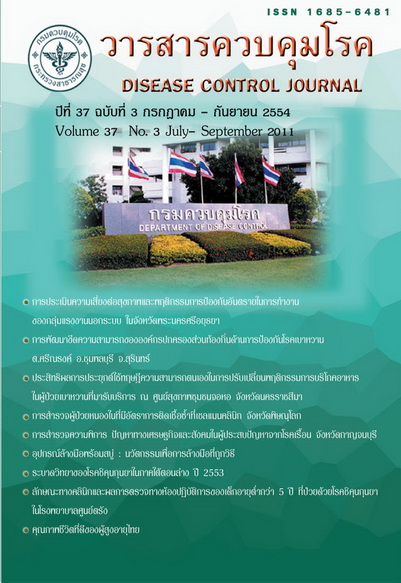Epidemic of Chikungunya in Southernmost of Thailand in 2010
Keywords:
Chikungunya, Epidemiology,, Southernmost ThailandAbstract
This study was a retrospective descriptive study aimed to study the epidemiology of chikungunya, disease prevention behavior, biology of Aedes albopictus, and environmental factors related to its feeding behavior. Three data sets such as, infectious epidemiological surveillance data, behavioral survey data, and mosquito biting and landing survey between 2009 and 2010 were collected. Results showed that first chikungunya case was reported in February 2009. Cases were increased in May 2009 and the highest cases in June 2009 that were 1,161 and 1,323 cases (morbidity rate 231.03 and 261.91 pop/100,000), respectively. Almost (63.00%) were female and (50.95 %) were agricultural career. Skin lotion or wearing shirt were used (68.95%) to prevent mosquito during rubber tapping and 54.52% used lotion and fan while resting in house. Aedes albopictus was found all year. Biting rate in-house, outside-house, and in garden were 0.47, 0.95 and 2.93 per man per hour, respectively. In lower south of Thailand, population was high susceptibility of chikungunya or emerging vector born diseases due to no firmed prevention in placed so that epidemic may occur if infected patients migrate.
Downloads
References
2. Renault P, Solet JL, Sissoko D, Balleydier E, Larrieu S, et al. A major epidemic of chikungunya virus infection on Reunion Island, France, 2005-2006. Am J Trop Med Hyg. 2007; 77: 727-731.
3. Delatte H, Paupy C, Dehecq JS, Thiria J, Failloux AB, Fontenille D. Aedes albopictus vector of Chikungunya and dengue viruses in Reunion Island. Biology and control. Parasite 2008; 15: 3-13.
4. WHO, Global Alert and Response (GRA). 17 Oct 2006. [cited 2010 Dec 1]; Available from: http://www.who.int/csr/ don/2006_10_17/en/index.html
5. P. Philip Samuel, R. Krishnamoorthi, K.K. Hamzakoya & C.S. Aggarwal. Entomo-epidemiological investigations on chikungunya outbreak in the Lakshadweep islands, Indian Ocean.Indian J Med Res 129, April 2009, pp 442-445
6. Halstead SB, Nimmannitya S, Margiotta MR. Dengue and chikungunya virus infection in man in Thailand, 1962-1964,II: Observations on disease in outpatients. Am J Trop Med Hyg 1969; 18: 972-83.
7. Pisittawoot Ayood, Thonchai Leatvilairatapong, Suwit Thumapalo, Jariya Naratippaput, Sawanya Juntutanon, Sulapee Anuntaprecha et al. Risk factors and Chikungunya viral serosurvey in a village, Yi-gno District, Narathiwat Province, October 2008. Monday meeting; 4 May 2009; Bureau of Epidemiology, Nonthaburi.
8. สำนักงานป้องกันควบคุมโรคที่ 12 จังหวัดสงขลา. ไข้ปวดข้อยุงลายในภาคใต้ตอนล่าง. พิมพ์ครั้งที่ 1. สงขลา: โรงพิมพ์ธีระวัฒน์เซ็นเตอร์; 2553.
9. U. Thavara, A. Tawatsin, T Pengsakul, P Bhakdeenuan, S Chanama, S. Anantapreecha et.al. Outbreak of Chikungunya fiver in Thailand and virus detection in field population of vector mosquitoes, Aedes aegypti (l) and Aedes albopicus skuse (Dipteria: Culicidae). South-East Asian J Trop Med Public Health. 2009; 40: 951-962.
10. Wonghiranrat W, Moonmek S, Wasinee S. Biting time of Aedes albopictus. Technical Consultation On the Re-emergence of Chikungunya fever; 26 - 28 August 2009; Graceland, Phuket Thailand.
11. สุวิช ธรรมปาโล, วิรัช วงศ์หิรัญรัชต์, โสภาวดี มูลเมฆ, และ วาสินี ศรีปล้อง. แหล่งเพาะพันธุ์ของยุงลายสวน ในพื้นที่ระบาดของโรคไข้ปวดข้อยุงลาย (ชิคุนกุนยา). วารสารโรคติดต่อนำโดยแมลง. 2553; (2) : 7-15
12. Alex Eapen, K. John Ravindran, A.P. Dash. Breeding potential of Aedes albopictus (Skuse, 1895) in chikungunya affected areas of Kerala, India. Indian Journal of Medical Research. 2010; 132(6): 733-735.
13. T. Ditsuwan, T. Liabsuetrakul, V. Chongsuvivatwong, S. Thammapalo, E. McNeil. Assessing the Spreading Patterns of Dengue Infection and Chikungunya Fever Outbreaks in Lower Southern Thailand Using a Geographic Information System. AEP. 2011; 21(4): 253-261.
Downloads
Published
How to Cite
Issue
Section
License
Articles published in the Disease Control Journal are considered as academic work, research or analysis of the personal opinion of the authors, not the opinion of the Thailand Department of Disease Control or editorial team. The authors must be responsible for their articles.


.png)



